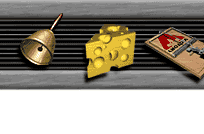Strategies for Weakening
Behaviors
To complete
this assignment successfully, you should:
- Study
the assignment carefully
- Enter
your response(s) in the space(s) provided
- Fill in
your Name and Email address
- Send the
Assignment
- Tally
up
 's
for completion of this assignment. 's
for completion of this assignment.
Assignment:
Identify and explain six or more strategies for weakening behaviors.
When student behaviors are dangerous to self or others, they require an
immediate response. If a behavior is stopped through one immediate and
noxious or startling experience, a punishment may have been administered.
There are times when a punishment is necessary. It is important to question
the outcome of intentionally applying aversive actions. Much like the
physics theory, it is a good guess that for every action there will be
a separate and equal reaction.
Consider
other options carefully, and only when nothing else will work, should
aversive stimuli be administered. There are many other ways to weaken
student behaviors.
Using the example from the previous reading, a child who sucks her thumb
could be given a piece of chewing gum. As gum chewing increases, the time
spent in thumb sucking lessens and the child's target behavior is weakened.
Giving a child gum is not a punishment. There are many excellent tools
for weakening target behaviors. This assignment could assist you in adding
some great intervention strategies to your classroom management repertoire.
Extinction
-- stops behavior instantly
One of the
ongoing debates in education surrounds consequences and punishment. Consequences
are not generally considered a part of behavioral tools. Natural and logical
consequences can be used in place of punishments. How are the two different.
Listen to the following example.
Vignette
- Larry is out of his seat and not paying attention to the reading task.
He seems to be caught up in thoughts of the upcoming basketball game that
is to take place over lunchtime. He moves near Nate and makes a comment
about being the Center for the game. He shadow plays making the last two
points. Undertones of "Basket, basket, basket boys, you make the
basket, we'll make the noise," keep coming from him as he wiggles
his hips and poses like a cheer leader.

Natural
consequences: Larry will have to do the work at home;
Larry
will not learn the material and won't do as well on the next assignment.
Larry
will alienate some of the students who want to work quietly.
The
teacher-student relationship is being strained.
Logical
consequences:
The
teacher walks close to Larry and gives him a verbal prompt about completing
his work and not bothering other students.
The
teacher looks around and realizes that nearly everyone is keyed up about
the lunch time ball game and decides to use a round robin basketball through
with the nerf ball, asking questions about the reading and materials.
The
teacher calms Larry and reminds him about getting control so he can get
his work done and do well in sports and academics. Remember, it is aversive
not a logical consequence if delivered with sarcasm or a veiled threat,
name calling, "the teacher voice."
Punishment:
"Larry, if you don't settle down and get your work done you can forget
the basketball game this lunch hour. You'll be sitting right here."

What
is the difference between punishment and consequence? Many authorities
do not think this is easy to distinguish. Some even say that teachers
use consequences when they mean something aversive.
Tips
on consequences
Article
| Incident recorded by Duen Hsi Yen http://www.noogenesis.com/malama/punishment.html |
|
Ivan Pavlov (1849-1936) also dog troubles of his
own, as described by one group of researchers working in his lab:
"In a famous experiment by Shenger-Krestovnika, published in 1921,
a dog was trained to salivate to a circle but not to an ellipse.
The ellipse was then made progressively more like a circle. When
the ratio of the axes of the ellipse was reduced to 9:8, the dog
could discriminate it from a circle only with great difficulty.
It showed some signs of success on this problem for about three
weeks, but then its behavior was disrupted. It was unable to respond
correctly not only on this difficult task, but also when presented
with obvious ellipses and circles that had given it no trouble
in the earlier part of the experiment. What is more, instead of
coming to stand quietly in the apparatus of the past, the animal
now showed extreme excitement, struggling and howling" (Gray,
1979).
This work was brought to my attention by a University
professor/psychotherapist, who also informed me that this dog
eventually had to be put to sleep! It never was able to recover
from the "experimental neurosis," induced by Pavlov. This result
is even more amazing because the conditioning did not involve
punishment! The dog was merely trained to perform a discrimination.
When it couldn't do it, it went crazy!
Later, Pavlov and his coworkers discovered lots
of other ways to create neurotic dogs. These results were so remarkable,
that at the age of eighty, Pavlov launched himself into an entirely
new career in a different field, to understand psychopathology.
He soon was visiting psychiatric wards several times a week, discussing
the various cases with the psychiatrists!
What is even more insidious, is that our entire
educational system, as it exists today, is based on this type
of learning! Children daily are asked by teachers to make discriminations
that they cannot make, and when they make a mistake, they are
punished! (The process is often referred to as "operant conditioning"
or instrumental learning.) The result is that we have become a
society of "low risk perfectionists." By the 5th grade, most children
will no longer risk answering a teacher's question unless they
are absolutely, positively sure that they have the correct answer!
I remember I became this way, because I literally
trembled with fear when I was called upon to answer, and I never
volunteered! The worst was when the teacher started asking questions
going around the room in alphabetical order. Because my name is
Yen, I was usually called last, and as a consequence, I spent
most of the class period dreading my turn! Needless to say, during
my school days, I didn't ask very many because I didn't want to
look 'stupid' or be called "dumb."
|
Personalizing
the concepts:
What is
the difference between punishment and consequences? There are three specific
things to note. 1) A consequence either occurs naturally, or is a logical
extension of the actions; 2) Punishment is typically all about the person
dishing it out. When it is not about power, control, who has the upper
hand, who is in charge, but rather about what to do to support a student,
help them gain self control, make better choices, it is more likely to
be a consequence or a learning experience; 3) Punishment is nearly always
a retribution - a getting even -- and it is a difficult thing for most
of us to hear.
Want more
questions to chat about?
 How do we weaken responses?
How do we weaken responses?  What is the difference between a punishment and a consequence?
What is the difference between a punishment and a consequence?  Is it possible to weaken a response using privileges and rewards? Are
there things students stop doing if they don't keep getting "paid"
for doing them?
Is it possible to weaken a response using privileges and rewards? Are
there things students stop doing if they don't keep getting "paid"
for doing them?  Does competition weaken or strengthen learning behaviors? Under what conditions?
Does competition weaken or strengthen learning behaviors? Under what conditions?
 When
does it make sense to keep students in or give them detention? When
does it make sense to keep students in or give them detention?
SUGGESTED STEPS TO COMPLETE ACTIVITY:
- Review
Chapter Three, pp. 128-9; 293-96; in Hyman.
- Explain
the differences between punishment and consequences.
- Discuss
the difference between natural and logical consequences.
- Write
at least six strategies for decreasing behaviors.
RUBRIC
The student develops a brief discussion of the differences among punishment,
and natural and logical consequences. In addition, at least six strategies
for decreasing target behavior are listed. To show extra depth, the
student may offer a critique of the pros and cons of the different tools.
|
















